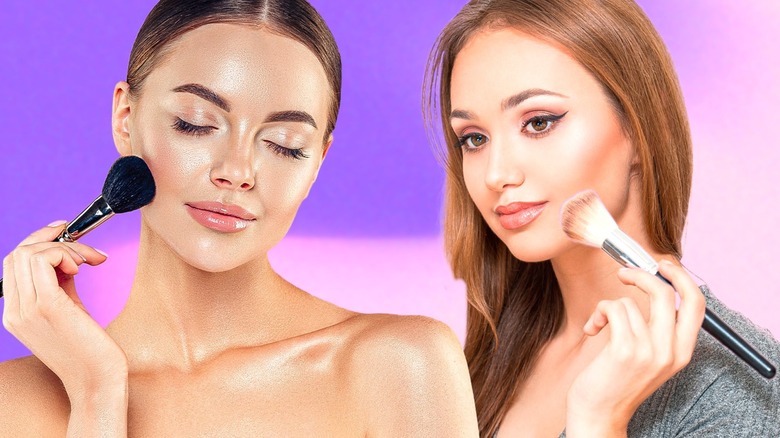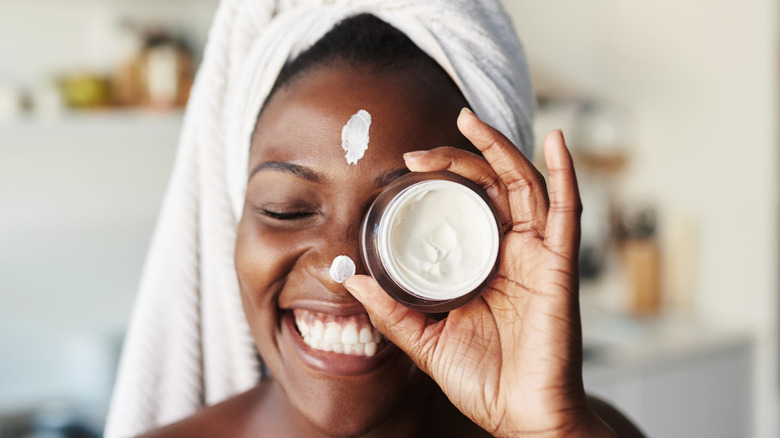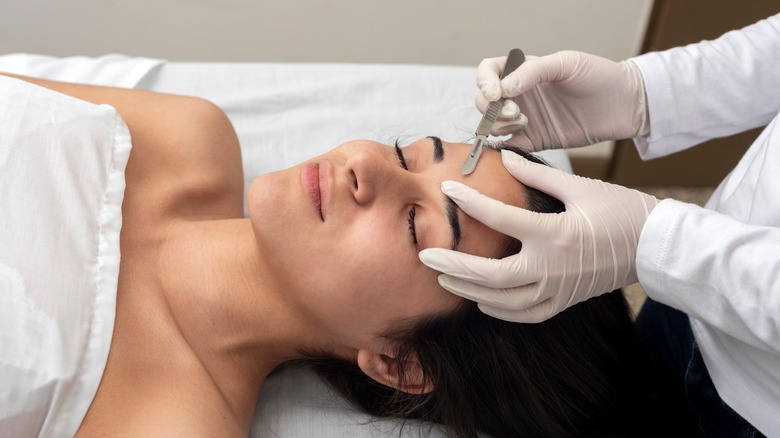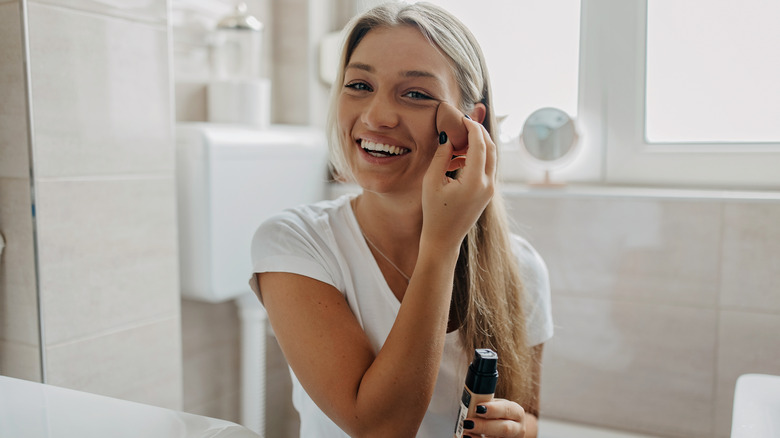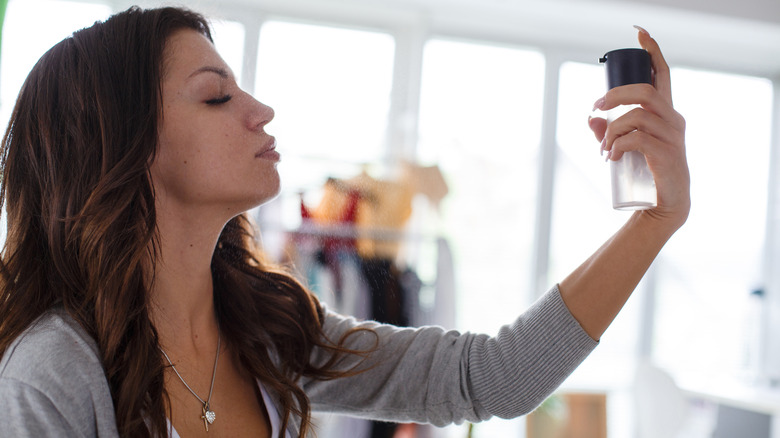Our MUA's Best Tips For Preventing Makeup From Looking Cakey
We may receive a commission on purchases made from links.
A compliment about your makeup is welcome when you've perfected a bold winged liner or experimented with a new lip color. But when going for barely there, no-makeup makeup, a comment about your beauty look could be a sign that your face has unintentionally turned cakey. Almost everyone who's worn foundation has experienced a cakey effect at one point or another, but for the uninitiated (consider yourself lucky), cakiness occurs when your cosmetics look heavy and overdone. As a result, the product may appear thick and sink into any skin creases — the exact opposite of what you typically want your makeup to do.
A cakey texture can distract from your natural beauty and dim your skin's glow. And to make matters worse, it's pretty hard to correct once it's been done (yep, that means you might have to bust out the makeup wipes and start over). Thankfully, there are ways to prevent a powdery, patchy look from happening in the first place. Denise Madrigal, celebrity hair and makeup artist with Cloutier Remix, shared her best tips exclusively with Glam so you never have to deal with cake face again.
Prep your skin first
If makeup brings out your inner artist, eyeshadow and blush are your paints, and your face is the blank canvas. But to get that canvas smooth and clean, you'll need to first invest some time in skin prep, says Denise Madrigal. "Skin prep is KEY to making your makeup last all day," the beauty expert tells us, adding that a good skincare routine can help your makeup stay put for eight hours or longer. Madrigal first suggests exfoliating to slough away any rough patches. However, note that this step should only be done as needed. According to Healthline, over-exfoliation can lead to redness, dryness, acne breakouts, and other signs of irritation. Just once or twice a week is enough for most people.
Another fundamental skin-prep step is moisturizing. "Every skin type will benefit from having moisture in the skin (no matter how oily you are)," Madrigal explains. Moisturizer acts as a base, protecting and hydrating the skin underneath the foundation and other makeup products. Without it, your face can lose moisture throughout the day, leading to dryness — and, as a result, a splotchy, caked-on makeup look.
Consider dermaplaning
Dermaplaning — a form of exfoliation that removes the top layers of skin, along with facial hair — may have seemed scary just a few years ago, but it's recently gone mainstream in medi-spas and on platforms such as TikTok (the #dermaplaning hashtag has 4.5 billion views and counting). If you're struggling with cakey makeup, Denise Madrigal says the trendy technique could be the answer. "NO, it does not make your peach fuzz grow in darker or thicker," she affirms. "Peach fuzz adds texture to skin and allows foundation to stick on the fuzz [thus] leaving an uneven application. When you remove the fuzz, it leaves your skin smooth and even and leaves a perfect base each time."
If you're new to dermaplaning, Cleveland Clinic suggests speaking to a doctor or dermatologist first. It might not be right for you if you have active acne breakouts, cold sores, a sensitive skin condition (such as psoriasis or eczema), or other skin irritation.
Match your primer and foundation
It's no secret that makeup primer can keep your makeup from going rogue on your face, but if you notice cakiness even after using a primer, it could be because your primer ingredients aren't compatible with your makeup. Denise Madrigal recommends matching the base of your primer and foundation for the best result. "Most primers and foundations out there are either water-based or silicone-based," the makeup artist explained. "You don't want to mix a water-based primer with a silicone-based foundation and vice versa. Use a water-based primer with a water-based foundation and a silicone-based primer with a silicone-based foundation. This will make a world of a difference and will prevent cakey skin and separated foundation."
Not sure what your products are made of? Scan the label for ingredients with a "-cone" or "-siloxane" suffix. If these ingredients are near the front of the list (listed as the second or third ingredient), it's probably silicone-based. If you don't see these ingredients, or if they're much further down the list, the product is probably water-based.
Keep your skin type in mind
If you've always wondered why your skin always seems to act up — whether it's those stubborn dry spots or that oily sheen that appears soon after washing your face — you can probably chalk it up to your skin type. Rather than battling your skin's natural type, Denise Madrigal suggests working with it to choose the best makeup for your face. "Luckily, it's 2023, and there's skincare and foundation for every type of skin out there," she says.
The goal, Madrigal explains, is to use your makeup to balance out any skin concerns. "Dry skin clients should opt for hydrating and glowy foundations whether it's light, medium, or full coverage. As for oily skin, lean more for a velvet or mattifying finish," she shares. To prevent cakiness, remember that less is often best. "Dust with a soft, light layer of powder. We still want our skin to look like skin if you want to avoid the cake look," notes Madrigal.
Finish with a setting spray
Just as skin prep is essential, so is the right finishing touch. According to Denise Madrigal, setting spray is the way to go to preserve your makeup look and inject additional moisture into the skin. "Setting spray will lock everything into place and will keep you from getting too caked up as well as making it last through your day or night!" the beauty pro tells Glam.
There are plenty of setting sprays to choose from, though it's important to stick to formulas that leave a natural finish. "Charlotte Tilbury is my absolute favorite to use on clients and myself, but Milani also nailed theirs," Madrigal adds.
When applying the setting spray, make sure to cover the entire face, though keep in mind that a light layer is often enough. Many setting sprays contain alcohol, which could cause dryness, according to skincare brand Paula's Choice. If you notice irritation, cut back or find a different setting spray better suited to your skin.
